What to feed the peppers after planting in the greenhouse, what fertilizers and when to use
Pepper is a vegetable that is often grown in vegetable gardens. For most novice vegetable growers, it seems that growing bell peppers is a difficult job. However, this is far from the case if you know how to properly care for the plant.
Young bushes need regular feeding. Therefore, it is recommended that you familiarize yourself in advance with what to feed the peppers in the greenhouse during and after planting.
Landing in the ground
Before planting seedlings in the ground, it is necessary to prepare the planting soil. Special fertilizers are introduced into it, to which urea and a little manure are added. When planting, small pits are made for planting seedlings. The distance between them should be 25-30 cm. Half a bucket of water must be poured into each prepared hole. If necessary, you can add a little potassium permanganate to it so that the first shoots appear faster.
It is recommended to plant young seedlings in the soil at the very end of May. By this time, more than five sheets should appear on them. In some cases, by the end of spring, the first flowers appear on the pepper bushes in a polycarbonate greenhouse.
The first weeks after planting, the seedlings must be covered with plastic wrap. To fix it, it is recommended to make special supports from wooden or metal rods. However, do not attach the film too tightly, as it will still have to be ventilated periodically.
Growing conditions
For the cultivation of sweet peppers, care must be taken to create optimal conditions. This is the only way to get the maximum amount of harvest. Mandatory growing conditions include the following:
- It is recommended to use only slightly acidic, fertile and light soil.
- Daylight hours for pepper should last no more than eight hours.
- During cultivation, it is recommended to take care of the air and soil temperature. The soil should be warmed up to 20 degrees, and the air to 25 degrees. With a decrease in these indicators, the development of pepper may stop.
- It is necessary to periodically water the young bushes. In this case, the first abundant watering is carried out 2 weeks after planting the plant. For this, only warm water is used, heated to 25 degrees.
- You need to feed the peppers regularly so that the plants have enough potassium.

Also, every vegetable grower should definitely know, because of what conditions, growing pepper can lead to failure:
- It is not recommended to use too dense soil, as it will have to be loosened regularly.
- Seedlings that have already been planted in the ground cannot be transplanted to another place.
- In the greenhouse, the temperature must not be increased, as this can negatively affect the growth of the bushes.
- Peppers should not be planted in areas where direct sunlight will fall on it, which can cause burns to young fruits.
Organic fertilizers
The first feeding of peppers in the greenhouse is carried out immediately after they have been planted in the ground. Quite often, organic fertilizers are used for this, with the help of which the development and rapid growth of young bushes is ensured.
Peat
Peat peppers in the greenhouse help to retain nitrogen in the soil. Most often, not pure peat is used, but a mixture prepared with the addition of manure. The scheme for creating such a compost is quite simple: part of the peat is mixed with manure and added to the soil. The prepared mixture can be improved with phosphate rock. For this, about 30 kilograms of flour is added to one ton of compost.
Prefabricated fertilizers
Often, organic residues are used to prepare high-quality compost. These include tops, dried grass and fallen leaves. All of these ingredients can be used to feed peppers in the greenhouse.
During composting, all ingredients are carefully compacted in a plastic or wooden container. Then they are filled with manure and infused for several months. Do not cover the containers as the compost contains too much nitrogen. You can add several kilograms of phosphorus and a little lime to the present compost.
Manure
Many growers prefer to fertilize bell peppers with manure. Fresh fertilizer contains a large amount of aggressive elements that can harm young shoots. Therefore, it is recommended to use already settled manure, in which there are practically no harmful components.
Dung humus is ideal for fertilizing peppers in a greenhouse. No more than three buckets of substrate are introduced under one bush. It is recommended to use a wide rake to distribute the manure evenly over the area.
Ash
Some people don't know how to feed peppers during flowering and fruiting. Quite often, ash is used for this, which contains a large amount of iron, phosphorus, manganese and boron. However, there is absolutely no nitrogen in it, so ash is introduced in parallel with nitrogen-containing dressings. This fertilizer is often used in areas with dense soil and high acidity levels. With the help of ash, the soil is loosened and the pH level is lowered.
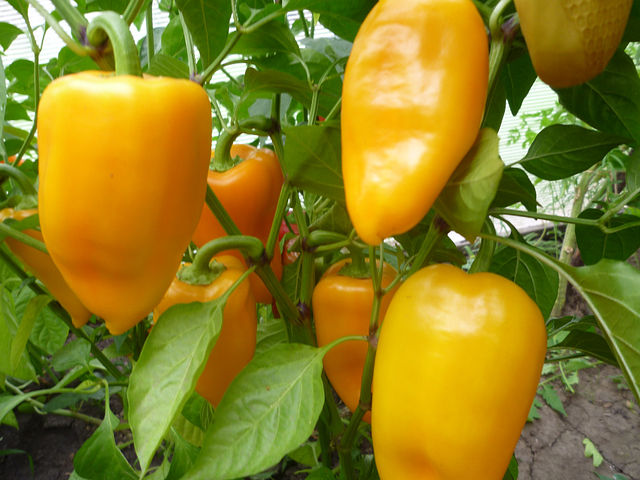
Many inexperienced gardeners use it when digging up beds, but this method is not very effective. It is recommended to use ashes for spraying on the ground surface. For this, a special mixture is prepared, which consists of 5 liters of water and one glass of ash. Then, with its help, the bushes of peppers and the surface of the soil are processed.
Bird droppings
It is not recommended to use fresh fertilizer as it contains urea. Most often, compost is prepared from bird droppings, to which peat, soil and sod are added. All components are mixed in the same amount and 15 liters of water are poured. Then the mixture is infused for several hours and mixed thoroughly. Sometimes iodine is added in small amounts. In order for the top dressing to be better absorbed, it should be applied to a previously moistened soil.
Also, bird droppings can be used as the main fertilizer. In this case, about two kilograms of fertilizers are applied per square meter. You need to repeat the procedure three times throughout the entire growing period.
Mineral fertilizers
Not everyone knows what mineral dressing can be used to feed peppers during cultivation. There are several types of fertilizers that are most commonly used.
Ammonia
Such dressings contain not only ammonia, but also chalk, phosphorus, limestone and phosphorus gypsum. Use ammonia fertilizers very carefully. They cannot be used in areas with podzolic soil, as this can negatively affect the beneficial properties of the soil.
With the correct use of ammonia dressings, you can protect young seedlings from many diseases and increase the yield by one and a half times.
Urea
This top dressing is almost half nitrogen. If it is scattered over the surface of the soil, then almost all the nitrogen will evaporate and ammonia is formed instead. Therefore, top dressing should be applied 5-10 cm deep so that it does not evaporate so quickly. Urea is versatile as it can be used in greenhouses and vegetable gardens. Quite often, it is used in liquid form, since an aqueous solution is better absorbed by the soil.
To feed the peppers, a special solution is created from 10-15 liters of water and 100 g of the substance. You can also add mullein to the mixture. The first time you can feed the plant a week after the start of flowering, and the second time after 5 weeks.
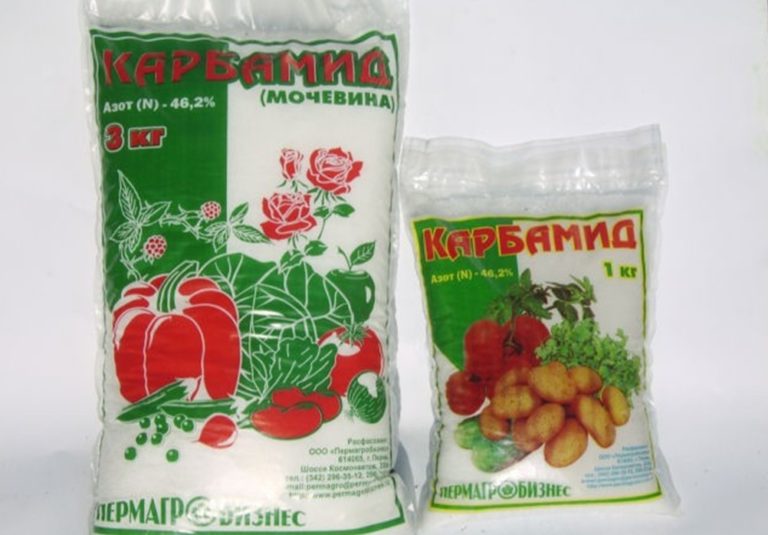
Potassium salt
The fertilizer consists of chlorides, which outwardly resemble small crystals with a reddish tint. Many gardeners use the most successful form of potassium salt - sylvinite. It is recommended to apply it in late spring or early summer. About 50 g of top dressing is consumed per bush of pepper.
Ammophos
Quite often, this complex fertilizer is used to feed peppers in a greenhouse. A distinctive feature of Ammophos is that it contains such a rare substance as sulfur. It is very convenient to use Ammophos, as it is crumbly. This allows it to be applied evenly to the soil surface.
Folk remedies for feeding
Various folk remedies are often used to feed young peppers.
Iodine
Iodine is very useful for vegetable seedlings. With its help, you can protect bushes from diseases and accelerate their growth several times. Iodine is used in parallel with watering bell pepper, adding it to clean and settled water. To create an iodine mixture, ten grams of the substance is mixed in a bucket of water and infused for several minutes. Iodine can also be used along with potassium and phosphorus.
Eggshell
Vegetable crops are often fed with eggshells and peppers are no exception. It contains a huge amount of nutrients that pepper needs. Anyone can prepare such fertilizer. To do this, place a shell of 2-3 eggs in a small container and pour warm water. The solution is infused for 2-4 days, after which the soil is treated with it.
Banana peel
People who prefer to feed plants with folk remedies often use banana peels for this. With its help, you can increase the amount of potassium in the soil. If there is little potassium in the soil, the bushes will begin to fade gradually.

To prepare the top dressing, five banana skins are placed in a two-liter jar and filled with boiled water. After that, the solution is infused for several days. During this time, the potassium must come out of the skins and fill the liquid. Foliar dressing of pepper in the greenhouse is carried out three times per season.
Yeast
Yeast is used to fill the soil with nutrients that are beneficial for the growth of peppers in a greenhouse. To create top dressing, two tablespoons of sugar are mixed with 20 g of yeast and 10 liters of water. If desired, iodine can be added to the solution.
Conclusion
Not everyone knows how to feed peppers after planting in a greenhouse. There are many different feeding methods that you need to familiarize yourself with before growing peppers.

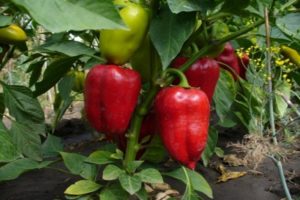
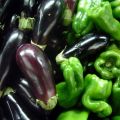

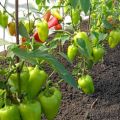
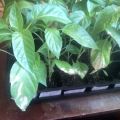
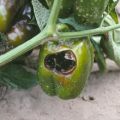

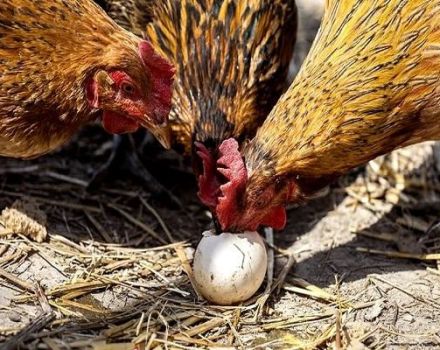
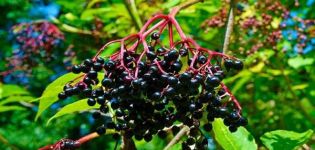
Peppers were planted with a neighbor in the country at the same time, but the result of growth was different. I fed BioGrow and he just watered. The remedy is excellent. I advise all gardeners to use for better growth. I bought it in this store.